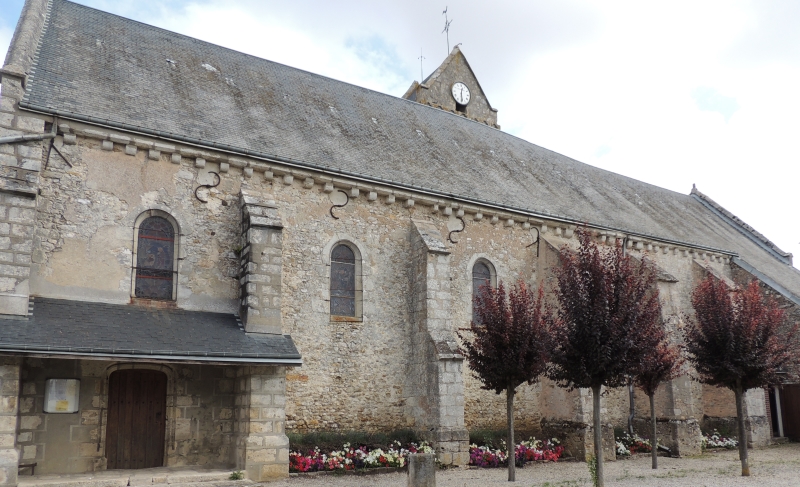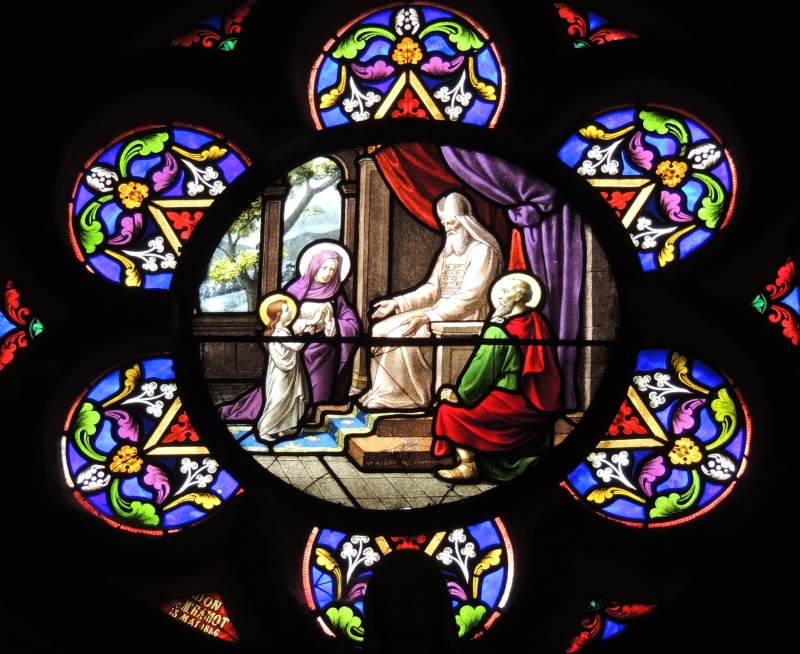The life of Marie Poussepin develops within almost two equal periods: the first in her hometown, Dourdan, from 1653-1695; the second in Sainville from 1696-1744.
FROM THE RICH CITY OF DOURDAN TO THE HUMBLE PEOPLE OF SAINVILLE
In Dourdan she receives from her parents a solid Christian formation, learning very quickly to love and alleviate the suffering of the sick poor, since she was attracted by the example of her mother, the treasurer of the Confraternity of Charity in Dourdan. A sure sign of her piety and religious formation is the fact that she was chosen 28 times as godmother for baptism in the two parishes of Dourdan.
When her mother died in 1675, Marie, with just 22 years, was called to replace her as the treasurer of the Confraternity of Charity, as well as the education of her brother Claude who was only 10 years old. Endowed with great ability for industrial business, she, in a short time pays off the huge debts of her father, a victim of a financial disaster in 1679. After the death of her father in 1683, she remained the only responsible person for the family business and with vision and audacity she renewed it. She initiated pioneering transformations by modernizing industrial manufacturing and positioning it as a major industry in Dourdan. She also amended contracts for the employment of apprentices and their remunerations, according to the spirit of evangelical justice.
From her youth, giving to the poor and her gaze upon God were marks of a deep faith that animated her entire life and commitment. Possibly, during the winter of 1695 – 1696, Marie Poussepin leaves Dourdan, to go to Sainville, a small village in the region of Beauce, located about seventeen kilometers from her hometown.
The wars and mismanagement during the reign of Louis XIV of France, leaves an imprint of misery, disease and ignorance among the peasants. Marie sees this actually as a clear sign of the will of God for her life. It is a call that demands that she orient herself and all her efforts in favor of the poorest. She arrives in Sainville with her cousin Agnès Revers and shortly afterwards other young orphan girls joined them. She uses all her assets to purchase and furnish a house where she soon begins a school for girls from Sainville. She also teaches them to weave silk and to care for the sick.
 Parish of Sainville
Parish of Sainville
BIRTH OF COMMUNITY
On November 13, 1697, Marie Poussepin signs an Act in front of the notary, which she explicitly declares her willingness to establish in Sainville "a Community of the Third Order of St. Dominic, for the benefit of the parish, for the instruction of youth and the service of the sick poor." Marie had expressed clearly her intention to establish not just a charitable organization or a working group to help the poor, but a stable community, rooted in Dominican spirituality, with a single rationale: the proclamation of Jesus Christ, for the service of charity. In the same act, Marie secures the future of the property to the community she founded: she gives the house she has bought to Noël Mesnard, her youngest companion, specifying the purposes for which she makes this donation. The house in Sainville welcomes the Sisters of the community and later becomes a place of reference for ongoing mission to other parishes. The house in Sainville also functions as a school, dispensary, workshops for weaving stockings, rooms for work etc.
The community is not limited to keep for itself the gifts received from heaven but will seek to scatter them in generosity and abundance
InnovATOR OF HER TIME
Innovative for her time, Marie Poussepin wanted neither cloister nor solemn vows for her sisters: "go wherever you are called" to provide charitable services there. Consistent with this insight, in 1697 she sent two sisters to the Hospital in Janville, a town thirty kilometers away from Sainville, at the request of the bishop of Orleans. To this request joined many others soon after. Piety, charity of the sisters and the effectiveness of their services encouraged bishops to request the presence of the sisters in the parishes.
From 1697 to 1740, Marie makes nineteen foundations in six dioceses. The sisters serve in small village schools, visit and care for the sick, work in hospitals, encourage, console and are ready to provide any service of charity. This willingness to "go beyond", to "leave one’s own borders” marks the community from its origins at the express wish of the founder: "The community is not limited to keep for itself the gifts received from heaven but will seek to scatter them with generosity and abundance.”
THE JUST WILL BE PURIFIED THROUGH THE TEST
The rapid growth and expansion, soon faces difficulties, as signs not less expressive of God's action in the new community. The bishop of Chartres prevents the affiliation to the Dominican community, fearing the danger of Jansenism, which at that time was hovering over the Order. Marie Poussepin knows that she must ensure the stability of the "Work of Providence" for which she needs to obtain a legal recognition. She writes to bishops, lawyers and influential people who can raise their voices to the authorities, she even goes to King Louis XV. She insists clearly and firmly, submiting to judgment those who know the purpose of her work, the procedures used and the way of life of the community. Seeking approbabion of the community, a petition from Parliament requests information from the neighbors in Sainville about the advantages and disadvantages of granting it, it is the priest Lamyre Lamothe, who is reported as the worst of her enemies. He states that "raise the altar against altar," for the services they offer in the chapel and gives false testimony about her charitable work. The neighbors are responsible for denying these findings. Her waiting is prolonged to thirty years, during which Marie remains steadfast in her trust in God. Finally, in March 1724, the king signed the official approval of the work that God has blessed. The faith of the Foundress, her firm hope overcomes resistances.
A LEGACY FOR THE FUTURE
Forty-two years of fidelity to the principles and rules for the community, each sister from the beginning, irrefutably guarantee each of the chapters of the "Rule of Sainville." Marie Poussepin did not improvise legislation for her community: she and her sisters lived it first and then put it in writing. The approval of the Rules by Bishop of Mérinville, on March 5, 1738, marks the moment when the Church officially recognizes the Community. When the missionary expansion begins outside Sainville, Marie Poussepin writes the "General Rules for the Conduct of the Sisters of the Community of Sainville sent on mission in the parishes". These General Rules and The Rule of Sainville for the Sisters of Sainville, are the synthesis of the original vision of Marie Poussepin: the purpose of the Congregation she founded, the traits that should identify her community and missionary project. They reflect the maturity of her soul, her personal harmony, her profound spirituality and deep human sense, the action of God and the docility of one who has placed herself in his hands. In this legacy, generations of Sisters are inspired since 1696, to live in fidelity according to the Charism of their Foundress.
 Stained-glass parish of SainvilleTHE FIRST COMMUNITY OF FEMALE DOMINICAN APOSTOLIC LIFE
Stained-glass parish of SainvilleTHE FIRST COMMUNITY OF FEMALE DOMINICAN APOSTOLIC LIFE
"Having possessed nothing for myself, I own nothing," writes Marie Poussepin in her last testament. God has made her an instrument of the work of Providence and she agrees to be the faithful and wise servant of this project with the unconditional surrender of her life and possibilities. Now, ninety years after having begun the journey of life, Marie perceives her nearing end. In the depth of her faith, she understands her approaching plenitude. Stripped, free and serene, she dedicates herself to prayer and silence. The Lord comes to search for her in Sainville on January 24, 1744, at the age of 90 years, 3 months and 10 days. At her death, Marie Poussepin leaves the first solidly established Community of female Dominican apostolic life.
IN THE FOOTSTEPS OF THE FOUNDRESS
The life of "humble, pious and charitable Marie Poussepin" is prolonged in time and space, in each sister, in every community of Dominican Sisters of the Presentation, through its three centuries of history. Europe, America, Asia and Africa are the four continents in the rich array of cultures from 36 countries that welcome the Congregation today. Sisters, faithful to the spirit of their Foundress, aware of the great changes that have occurred in society and the variety of the towns where they are inserted, live the service of charity, through a great diversity of responses to the needs of the world.
In schools, colleges, universities and centers for human promotion and formation, the sisters strive for integral Christian formation of children, youth and adults, with preference for the poorest; in small clinics and health centers in the jungles or mountains, as well as in large hospitals and clinics in the city, they welcome and defend life, relieve pain and give hope. The elderly, the homeless children, the socially marginalized by leprosy, drug addiction, mental disabilities are offered care to defend their human dignity that lies beyond appearances and seem worthless for the rest of society.
In great zones of urban and rural marginalization of the third World, among indigenous and peasants, as in suburbs and towns of migrants in the first world, the sisters defend the human rights of the most vulnerable and are at their side to share their destiny and strive to achieve for them more dignified living conditions. In parishes and mission areas, through media, in government agencies or the Church, they are directors and animators of programs of evangelization; they become mediators of the Christian message in situations of work and in ordinary life of the men and women of our world.
With this diversity of responses and unity of the same spirit, the Congregation founded by Marie Poussepin, the DOMINICAN SISTERS OF CHARITY OF THE PRESENTATION OF THE BLESSED VIRGIN do not deviate from the sole purpose that she wanted to give: proclamation of Jesus Christ for the service of charity. This fidelity of three centuries, is proof of the holiness of its Foundress, the Church officially recognized it on November 20, 1994, at the ceremony of her beatification.
Source: Cfr. Booklet "Una vida al servicio de la Caridad"